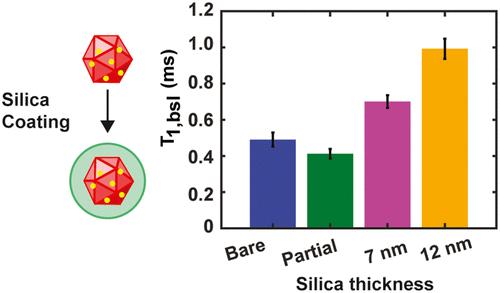Functionalized Fluorescent Nanodiamonds with Millisecond Spin Relaxation Times
IF 16
1区 材料科学
Q1 CHEMISTRY, MULTIDISCIPLINARY
引用次数: 0
Abstract
Fluorescent nanodiamonds (FNDs) containing nitrogen-vacancy (NV) defects are useful probes for biological imaging and nanoscale sensing applications. Here, we explore the effect of chemical surface modifications and core–shell structures on the T1 relaxation times of 100 nm FNDs hosting nitrogen-vacancy ensembles. The results show that surface oxidation and silica coating of FNDs using the Stöber method can dramatically increase the spin relaxation time from T1 = 320 ± 9 μs to T1 = 1.00 ± 0.06 ms. Using FT-IR and NEXAFS measurements conducted on air oxidized particles, we find that changes to surface functional groups and sp2 carbon density may be responsible for the observed enhancements to the spin relaxation rate. Finally, we use a Monte Carlo model to numerically investigate the relationship between chemical sensitivity and shell thickness and find that a shell thickness on the order of 1 nm should provide the highest sensitivity. Our findings demonstrate that the surface of FNDs can be engineered to exhibit bulk-like T1 relaxation times, in the absence of complex quantum control sequences, which is crucial to advancing biosensing and imaging applications where surface spin noise currently limits measurement precision.

具有毫秒自旋松弛时间的功能化荧光纳米金刚石
含有氮空位(NV)缺陷的荧光纳米金刚石(FNDs)是生物成像和纳米级传感应用的有用探针。在这里,我们探讨了化学表面修饰和核壳结构对承载氮空位系综的100 nm fnd的T1弛豫时间的影响。结果表明:Stöber方法对FNDs进行表面氧化和二氧化硅涂层,可将自旋弛豫时间从T1 = 320±9 μs显著提高到T1 = 1.00±0.06 ms;利用FT-IR和NEXAFS对空气氧化颗粒的测量,我们发现表面官能团和sp2碳密度的变化可能是观察到的自旋弛豫速率增强的原因。最后,我们使用蒙特卡罗模型数值研究了化学灵敏度与壳体厚度之间的关系,发现壳体厚度在1 nm左右时应提供最高的灵敏度。我们的研究结果表明,在没有复杂量子控制序列的情况下,fnd表面可以被设计成具有类似体块的T1弛豫时间,这对于推进生物传感和成像应用至关重要,因为表面自旋噪声目前限制了测量精度。
本文章由计算机程序翻译,如有差异,请以英文原文为准。
求助全文
约1分钟内获得全文
求助全文
来源期刊

ACS Nano
工程技术-材料科学:综合
CiteScore
26.00
自引率
4.10%
发文量
1627
审稿时长
1.7 months
期刊介绍:
ACS Nano, published monthly, serves as an international forum for comprehensive articles on nanoscience and nanotechnology research at the intersections of chemistry, biology, materials science, physics, and engineering. The journal fosters communication among scientists in these communities, facilitating collaboration, new research opportunities, and advancements through discoveries. ACS Nano covers synthesis, assembly, characterization, theory, and simulation of nanostructures, nanobiotechnology, nanofabrication, methods and tools for nanoscience and nanotechnology, and self- and directed-assembly. Alongside original research articles, it offers thorough reviews, perspectives on cutting-edge research, and discussions envisioning the future of nanoscience and nanotechnology.
 求助内容:
求助内容: 应助结果提醒方式:
应助结果提醒方式:


